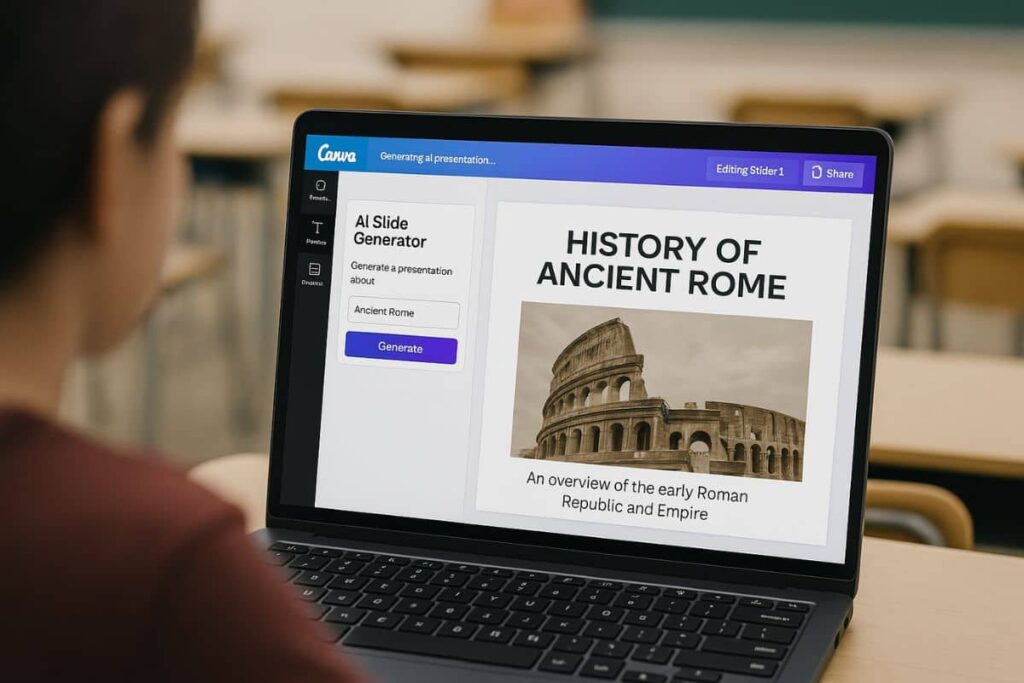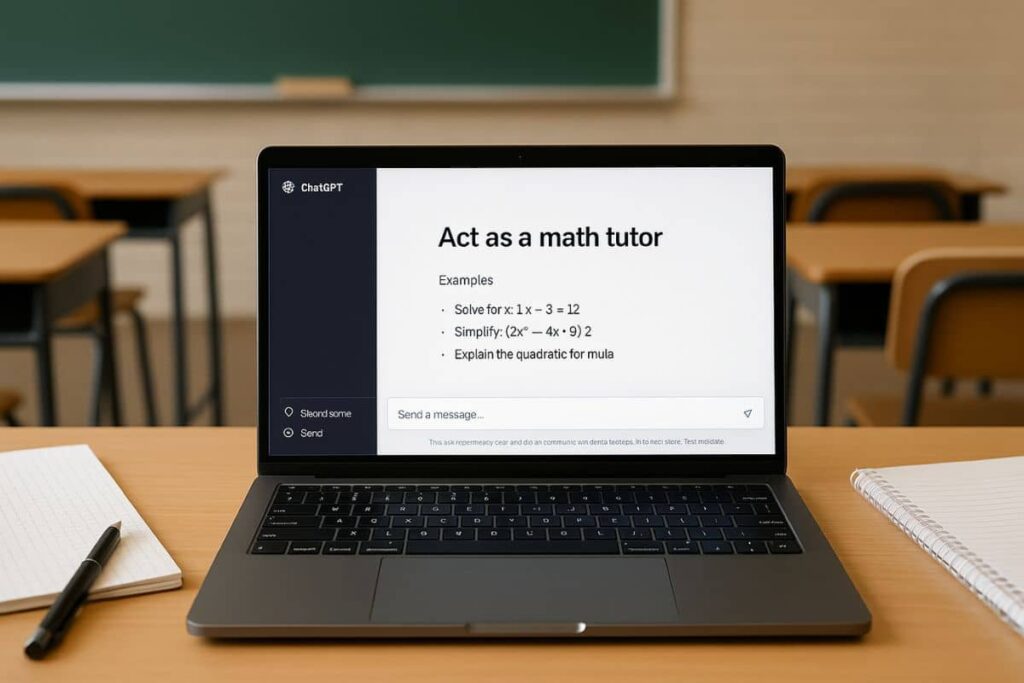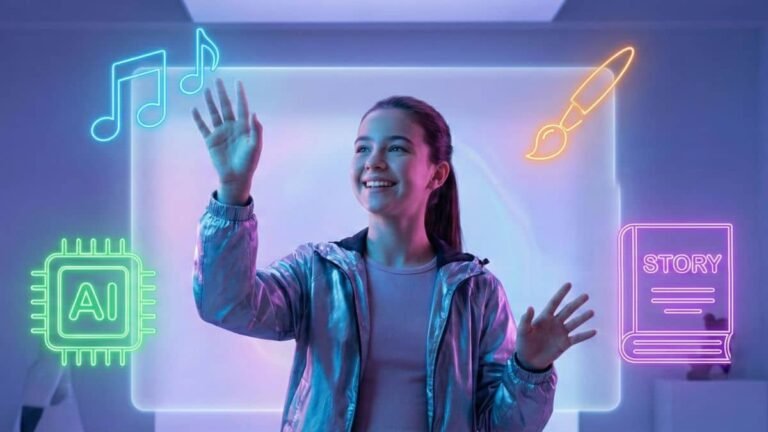Address
251 Little Falls Drive, Wilmington, DE 19808, United States

Think AI is just for tech geniuses? Think again. From science fairs to group presentations, AI projects for school are making learning more exciting than ever. Whether you’re working solo or with classmates, today’s AI tools are simple, powerful, and fun. Ready to build something amazing? Let’s dive into the creative world of classroom AI that’s changing how students learn and share ideas.
Table of Contents
Why AI is the perfect classroom companion
Artificial Intelligence isn’t just for tech labs and sci-fi movies, it’s making classrooms smarter and more fun. For high school students, AI projects for school are becoming a creative way to explore new subjects, collaborate with classmates, and build real-world skills. Whether you’re into art, science, or math, there’s an AI tool waiting to help you unlock your next big idea.
Instead of just learning about AI, why not experience AI hands-on? These tools are intuitive, often free, and designed for curious minds like yours.
What makes AI projects for school friendly?
Not all AI projects for school are created equal. The best ones are:
- Simple to start — no coding required.
- Safe and age-appropriate.
- Creative — they allow for student expression.
- Relevant to subjects like science, history, or literature.
And most importantly, they can be done during class or at home using just a laptop and a bit of imagination.
If you’re curious how these tools also spark imagination in younger learners, check out our guide on creative AI for kids. Most school-friendly projects can be done during class or at home using just a laptop and a bit of imagination.
Easy AI projects for school students can start today
AI-Powered storytelling with Character.ai
Character.ai lets you create virtual characters who respond like real people. Want to write a historical fiction story? Create a character who talks like Napoleon or a time-traveling scientist. It’s a powerful way to boost writing and creativity while exploring AI-generated dialogue.
Using machine learning to sort everyday objects
With tools like Google’s Teachable Machine, you can build a model that recognizes objects using your webcam. For example, sort recyclable vs. non-recyclable items as part of a science or environmental AI projects for school. It’s hands-on, visual, and mind-blowingly simple to use.
Using Canva AI to create school presentations easily
If you’ve ever struggled to design a school presentation, Canva’s AI Presentation tool will change everything. Just enter a prompt like “Create a presentation about the history of flight,” and Canva builds your slides automatically; complete with images and layout suggestions.
You can customize the design, add notes, and collaborate with classmates directly inside Canva. It’s especially great for group assignments or visual storytelling.

DIY AI Science fair ideas using Google’s Teachable Machine
Looking to stand out at the next science fair? Teachable Machine can be the heart of your project. Try these ideas:
- Train a model to recognize different emotions based on facial expressions.
- Classify plant leaves by type using image recognition.
- Detect sound levels in different classrooms to study noise pollution.
No advanced programming is needed, just upload photos, videos, or audio clips, train your model, and you’re ready to show off your AI science demo.
How to use ChatGPT in class projects: The “Act As…” trick
One of the most exciting ways to use AI in school is with ChatGPT. It’s like having a flexible assistant who can instantly adapt to any role you give it. All you have to do is start your prompt with: “Act as…”
This strategy allows you to simulate real-world conversations, complete assignments, or get help with tough problems. You can use it individually or even project it on a classroom screen during group discussions.
Examples: ChatGPT for Math, Science, and Economics
- Math class: Ask it to “Act as a math tutor” and walk you through algebra problems step by step. It’s like having extra support during homework or revision sessions.
- Science class: Try “Act as a lab assistant” to generate hypotheses, analyze experiment data, or simulate results when resources are limited.
- Economics: Use “Act as a financial analyst” to build mock reports, explain supply and demand in real-world terms, or evaluate fake case studies for presentations.
This technique is especially useful during class collaborations. One student can write prompts, another can review ChatGPT’s response, and others can debate or refine it, all while the teacher guides the activity. It turns passive lessons into active learning labs.

Collaborative exercises with classmates and teachers
Here’s a fun exercise: split the class into small groups. Each team gives ChatGPT a different “Act as…” role. Then they present how their “AI character” would solve a shared classroom challenge (like reducing waste at school or planning a field trip budget).
Students learn not only how to use AI, but how to think critically and work in teams: two skills that matter far beyond the classroom.
AI ethics and safety: What students should know
Using AI is fun, but it also comes with responsibility. Students should understand basic AI ethics to avoid misuse and misinformation.
- Always fact-check AI-generated answers.
- Never input personal information or sensitive data.
- Give credit if you use AI to assist in a school project or presentation.
Teachers can lead short discussions about bias in AI, data privacy, and the role of human judgment. This not only builds digital literacy but prepares students for the future of work.
Real student success stories with AI projects for school
Across the globe, students are already using AI to create incredible work. Here are a few examples:
- Two teens from Oregon built an AI chatbot that helps younger students study for biology exams using flashcard-like prompts.
- A school in the UK ran a competition where students used AI to design smart school lockers with facial recognition and energy-saving features.
- A high school art class in Canada used AI image generators to reimagine famous paintings as futuristic cityscapes.
These aren’t just gimmicks, they’re real learning experiences that combine tech skills with creativity and problem-solving.
Getting started: Tools and tips for your first AI project
Ready to dive in? Here are some student-friendly tools to kick off your journey:
| Tool | What You Can Do |
|---|---|
| Teachable Machine | Train models with images, sounds, or poses |
| Canva AI | Create beautiful slideshows from simple prompts |
| ChatGPT | Write, simulate roles, explain concepts, and more |
Start with a small project. Invite friends. Share your results. The goal isn’t perfection, it’s exploration. Every mistake is just another step toward mastering the future.
Advanced AI project ideas for ambitious students
If you’ve already tried beginner tools like Canva or Teachable Machine, it might be time to explore more advanced, but still accessible, AI projects for school. These ideas are perfect for tech-savvy students or those in STEM clubs:
- Create a custom chatbot using platforms like Dialogflow or Botpress. Imagine a virtual tour guide for your school or a quiz bot for exam prep.
- Build a basic image classifier using Python and TensorFlow Lite to recognize school supplies, sports equipment, or plant species for biology class.
- Use AI to analyze survey data collected from your classmates on topics like screen time, sleep habits, or favorite subjects, then visualize it using charts or dashboards.
These projects push boundaries while connecting directly with curriculum goals. Plus, they make for impressive portfolio pieces for college applications or scholarships.
Turning AI projects for school into presentations or portfolios
One of the smartest things you can do with an AI project is document your process. This turns a fun experiment into something you can show off later. Here’s how:
- Take screenshots at each major step: training models, writing prompts, generating results.
- Explain your decisions: Why did you choose this tool? What challenge were you solving?
- Reflect: What worked well? What would you improve next time?
Use tools like Canva to turn these into slides, or build a one-page website using Google Sites. You can even present it during school exhibitions, open houses, or in digital portfolios.
Tips for teachers: Bringing AI into the classroom
Educators don’t need a tech degree to make AI part of the learning journey. Here are simple ways to integrate it into your classroom:
- Start small: Introduce one tool per term: like ChatGPT in English class for essay brainstorming or Teachable Machine for science labs.
- Encourage group work: Let students explore tools together and present findings.
- Lead ethical discussions: Talk about AI bias, misinformation, and responsibility in a guided, age-appropriate way.
AI isn’t about replacing teaching, it’s about expanding possibilities. With the right framework, it becomes a partner in creativity, critical thinking, and deeper engagement.
What’s next: The future of AI in schools
We’re only scratching the surface of what’s possible. As AI becomes more intuitive and accessible, students will use it not just to complete assignments, but to invent, design, and even teach.
Imagine student-created AI tutors for younger grades, or virtual science labs where students can simulate complex experiments. These are more than dreams, they’re projects already taking shape in classrooms around the world.
By embracing AI projects for school today, you’re not just keeping up with technology, you’re leading the way. So gather your friends, open your laptops, and start building the future, one creative project at a time.
Bonus: AI clubs and competitions: level up your projects
If you’re passionate about AI and want to take your skills beyond the classroom, joining an AI club or competition is a game-changer. These groups give students the space to experiment, collaborate, and even win scholarships or national recognition.
Start or join a school AI club
Many high schools now have tech or robotics clubs but why not start one focused entirely on AI? You can meet weekly to explore tools like ChatGPT, Teachable Machine, or image generators. Each member could lead a mini project, like training a model or building an AI-powered quiz.
Even better, invite a teacher to mentor your group or partner with a local university to bring in guest speakers. It’s a great way to deepen your learning and build leadership experience.

Enter AI competitions
AI competitions give you a real-world reason to polish your project and push your limits. Look out for:
- AI for Good challenges — where students solve global issues using machine learning.
- Hackathons — fast-paced team events where you create something amazing in 48 hours.
- Science fairs with AI categories — a perfect place to show off your school-ready projects.
These opportunities aren’t just fun, they also look great on college applications and resumes. They show initiative, teamwork, and the ability to use emerging technology in creative ways.
So if you’re ready to go beyond class assignments, plug into your local AI scene. You’ll meet other curious minds, build bigger projects, and maybe even launch something the world’s never seen before.
Creative, practical, and endlessly customizable, AI projects for school are the perfect way to make learning meaningful. With tools like ChatGPT, Canva AI, and Teachable Machine, students can turn curiosity into real-world skills. Don’t wait for the future, start shaping it now. Try one project, share it, and inspire others to explore the possibilities of AI in the classroom.










